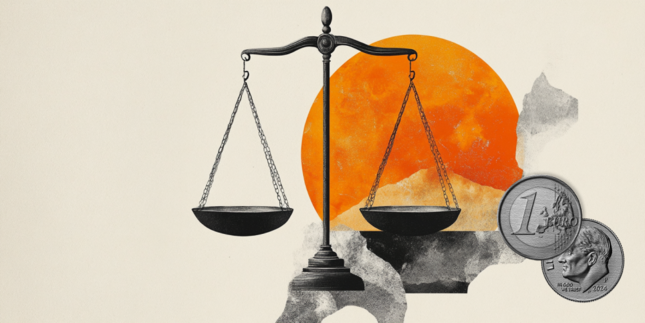-
The BoJ has taken up a much more aggressive strategy and we no longer expect them to wait for all the pieces to fall in place before tightening policies further.
-
We expect the BoJ will hike its policy rate to 1% within the coming 12 months.
The rate hike on 31 July was pivotal for how we see the Bank of Japan (BoJ) moving forward. On the press conference following the meeting, Governor Ueda had turned much more hawkish and the building of an economic momentum fostering 2% selfsustained inflation no longer seems to be the only thing that matters. Instead, the yen has taken centre stage. Earlier, FX moves was just one of many parameters, the BoJ monitored when gauging inflation momentum and it was never the key factor. An obvious example of this was the Friday 26 April policy meeting, when a dovish governor Ueda did not pay much attention to a very weak yen. As a result, USD/JPY tested 160 the following Monday and the Ministry of Finance ordered the BoJ to step in to prop up the yen. Now Ueda says, “FX moves are more likely to affect inflation than before”. So why this turnaround? The BoJ has intervened for USD161 billion since they stepped in for the first time in September 2022. It is a costly affair to defend the yen and intervention was probably never meant to be a long-term solution.
The hawkish turnaround should perhaps also be viewed in the light of a very low approval rating for PM Kishida and his cabinet. Just 25% approved in August, below the so-called danger level of 30%, an uncomfortable situation for Kishida considering recent history and the upcoming Liberal Democratic Party leadership election in September. Excluding Shinzo Abe’s eight-year reign from 2012-2020, the last seven prime ministers have only had about one year in power.
A very weak currency is usually not popular with the public and in Japan it creates quite visible inflation due to the status as a major energy importer. Gasoline for instance costs JPY175 per litre now, which is about JPY25-30 more than pre-pandemic levels. That is a big price increase in 4-5 years. Back in May, a poll from the private think tank, Teikoku Databank, showed 64% of companies see the weak yen as having a negative impact on their profits. Afterall, most Japanese companies are not in a position to exploit the advantages of a weak currency on export markets but only experience the flip side, which is higher import costs. About half of the respondents saw USD/JPY at 110-120 as an appropriate level. Largely, a weak currency benefits major exporters at the expense of consumers. That process can create inflation but will be painful for consumers until business profits are passed on to employees. We have seen the beginning of that process with the spring wage increases and real earnings recovered most of the lost purchasing power from 2021, in Q2. A lot of the June pay increases are one-off payments, though, and growth in real contractual cash earnings remains modest. The reality for most consumers is still that much of their purchasing power has been eroded and that is also key to understand why real household spending was still down 1.4% yoy in June.
This publication has been prepared by Danske Bank for information purposes only. It is not an offer or solicitation of any offer to purchase or sell any financial instrument. Whilst reasonable care has been taken to ensure that its contents are not untrue or misleading, no representation is made as to its accuracy or completeness and no liability is accepted for any loss arising from reliance on it. Danske Bank, its affiliates or staff, may perform services for, solicit business from, hold long or short positions in, or otherwise be interested in the investments (including derivatives), of any issuer mentioned herein. Danske Bank's research analysts are not permitted to invest in securities under coverage in their research sector.
This publication is not intended for private customers in the UK or any person in the US. Danske Bank A/S is regulated by the FSA for the conduct of designated investment business in the UK and is a member of the London Stock Exchange.
Copyright () Danske Bank A/S. All rights reserved. This publication is protected by copyright and may not be reproduced in whole or in part without permission.
Recommended Content
Editors’ Picks

EUR/USD regains 1.0300 ahead of Trump’s inauguration
EUR/USD regains 1.0300 in the European session on Monday. The pair benefits from the market optimism-led US Dollar weakness as traders brace for the highly anticipated President-elect Donald Trump’s inauguration later in the holiday-thinned day.

GBP/USD battles 1.2200, awaits Trump 2.0
GBP/USD is battling 1.2200 in European trading, paring back gains. A broadly weaker US Dollar underpins the pair but markets turn cautious ahead of US President-elect Donald Trump's inauguration, capping its upside.

Gold price sticks to modest gains above $2,700 amid renewed USD selling
Gold price attracts some dip-buyers at the start of a new week and builds on its steady intraday ascent through the early European session. The US Dollar attracts fresh sellers and erodes a major part of Friday's positive move amid bets that the Fed will cut interest rates twice this year.

Bitcoin, Ethereum, and Ripple expect volatility ahead of Trump’s inauguration
Bitcoin and Ethereum prices retest their key support level on Monday, with an eye on a rally ahead. At the same time, Ripple continues its rally on Monday after breaking above its symmetrical triangle pattern last week.

Five keys to trading Trump 2.0 with Gold, Stocks and the US Dollar Premium
Donald Trump returns to the White House, which impacts the trading environment. An immediate impact on market reaction functions, tariff talk and regulation will be seen. Tax cuts and the fate of the Federal Reserve will be in the background.

Trusted Broker Reviews for Smarter Trading
VERIFIED Discover in-depth reviews of reliable brokers. Compare features like spreads, leverage, and platforms. Find the perfect fit for your trading style, from CFDs to Forex pairs like EUR/USD and Gold.